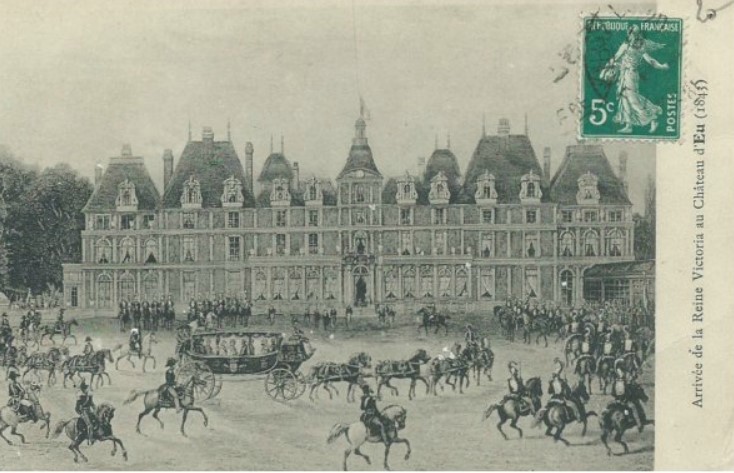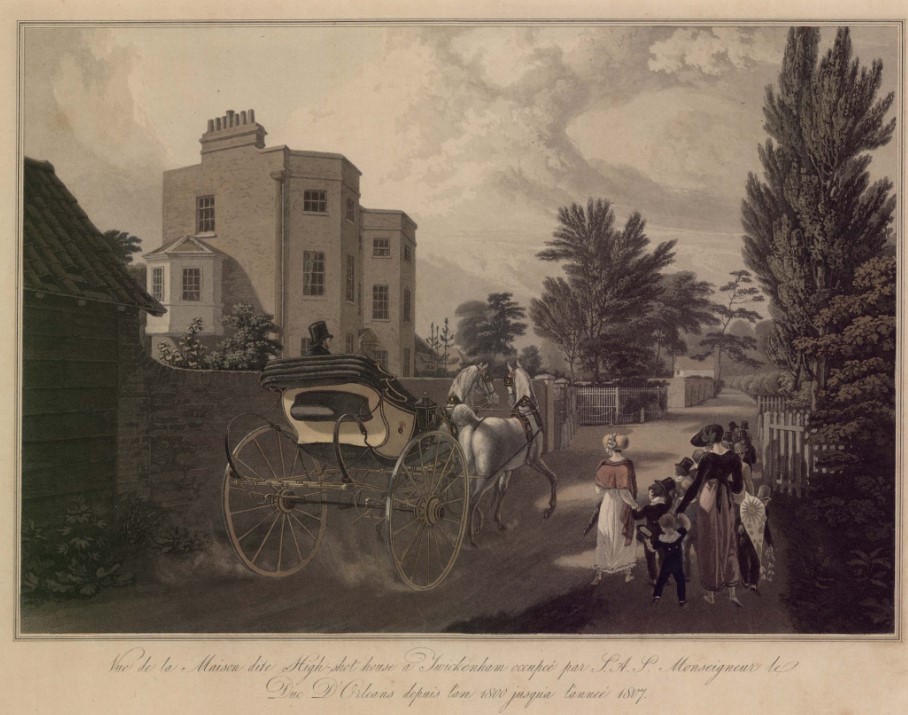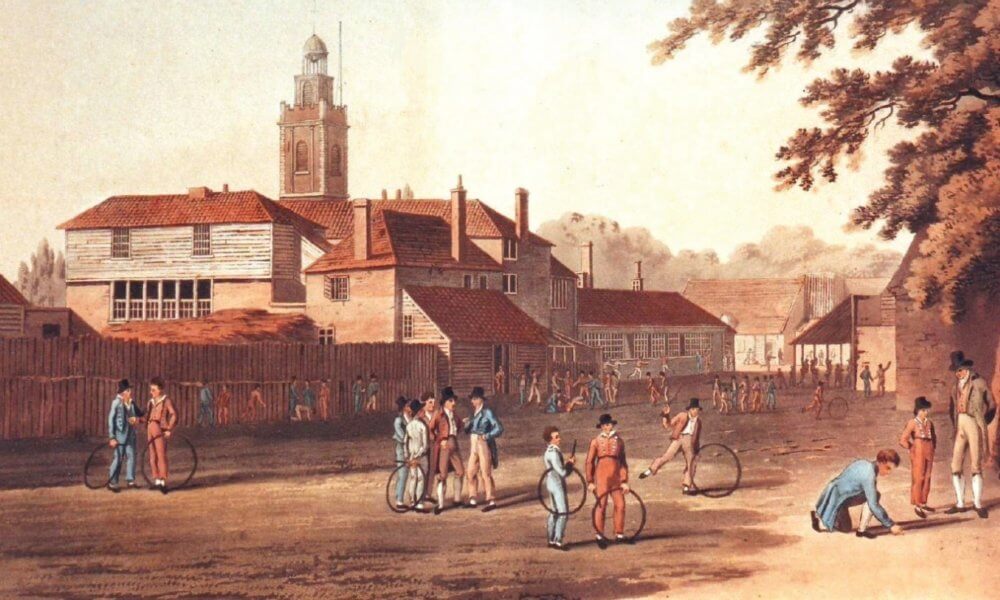Tuesday 9 June 2020
Collection Focus – Louis Philippe during his visit to Queen Victoria of Britain
In this week’s Collection Focus, volunteer Michele investigates the important history behind this lithograph, with Louis Philippe and his connection with Britain.

This lithograph is of Queen Victoria’s visit to France and her meeting with Louis Philippe I, King of the French. The scene shows Queen Victoria, Prince Albert, Louis Philippe, King of the French, his wife Maria Amalia of Naples and Sicily, Leopold I, King of the Belgians and his wife Louise of Orléans, who was also Louis-Philippe eldest daughter.
At the centre, Queen Victoria extends her hands to Maria Amalia, with coats of arms below and the French inscription, including the French and English publisher’s address, ‘Paris J. BULLA fils et F. DELARUE, seurs. de M. AUMONT rue J-J- Rousseau, 10.’ and ‘Published London by GAMBAR and JUNIN, 12 Denmark St. Soho.
The original lithography of this work is held in the Royal Collections. Its original title was Louis-Philippe 1er. recvit la Visite de Victoria, Reine d’Angleterre. [Louis-Philippe I receives the Visit of Victoria, Queen of England].
This is a copy of a lithograph by Nicolas-Eustache Maurin c. 1844, French engraver. He was born in Perpignan, France on 6 March 1799 and died in Paris in 1850. He was the son of Pierre Maurin and brother of Antoine Maurin, both pupils of the painter Henri Regnault; they both exhibited at the Paris Salons of 1833, 1834 and 1835.
Not much is known about him, he specialised in lithography and iconographic works, of which 437 are held at the French National Library in Paris (Bibliothéque Nationale de France).
Queen Victoria and Prince Albert visited Louis Philippe at the Château d’Eu in Normandy from 2 to 7 September 1843. The castle was the property of the Orleans family and their summer residence. This had made headline news at the time, as it was a symbolic gesture of friendship; it was a remarkable event as only three years earlier, Great Britain and France had been on the brink of war with each other. It was the first visit entitled ‘Entente Cordiale’ – George Hamilton Gordon, Earl of Aberdeen, as head of the Foreign Office, used the phrase “a cordial good understanding” in October 1843, echoed by Louis Philippe in his speech inspired by Guizot where he referred to “une sincère amitié” and a spirit of “cordiale entente”. Victoria used these same expressions before Parliament in February 1844.

Before and after his reign as King of the French (1830-1848), Louis Philippe, who was also Duke of Chartres and Duke of Orleans, lived in exile in England. As Duke of Chartres he would command troops during the Revolutionary Wars but fled to Switzerland in 1793 after being connected with a plot to restore France’s monarchy. He then travelled extensively with his three brothers.
In the late 18th century, they sailed from Cuba, via the Bahamas, to Nova Scotia where they were received by the Duke of Kent, son of King George III, who Louis Philippe struck up a lasting friendship with. In January 1800, they arrived in England, where they stayed for the next fifteen years.
From his arrival until 1807, he lived with his two younger brothers at Highshot House in Crown Road in Twickenham, living in relative poverty.

Antoine, Duc de Montpensier, died in 1807 from tuberculosis and is buried in Westminster Abbey. Louis Charles, Comte de Beaujolais died in Malta in 1808.
During this time, Louis Philippe taught mathematics and geography at the now-defunct Great Ealing School, reckoned to be ‘the best private school in England’ in its heyday.

Whilst in England, he reconciled with his Bourbon relatives and fellow exiles, including Louis XVIII nicknamed ‘The Desired’, who became King of France from 1814 to 1824.
Louis Philippe left England in November 1809 to marry Princess Maria Amalia in Palermo. She was the daughter of King Ferdinand I of the Two Sicilies and Archduchess Maria Carolina of Austria; she was also the niece of Marie Antoinette, the last Queen of France beheaded during the Revolution.
The couple settled in Sicily and on the 17 May 1814, Louis Philippe returned to France hoping a for new role in the reign of the new King Louis XVIII. However, the latter was reluctant to let Louis Philippe have a position in his government and the former spent his time managing his fortune, returned to him.
Louis Philippe and his family fled France once again to find refuge again in England, during the period known as the ‘Hundred Days’. This marked the return of Napoleon from exile from 20 March 1815 to his second abdication on 22 June. However, On Napoleon’s abdication, Louis XVIII returned to the throne but his relations with Louis Philippe were strained as the latter openly supported the Liberal opposition, making his return to France impossible. He leased Orleans House from 1815 to 1817, giving it its present name.
In 1817, Louis Philippe and his family were allowed to return to France. In 1824, at the death of Louis XVIII, his brother Charles X became King and Louis Philippe, who was on better terms with the new King, saw his Royal titles returned to him. After the 1830 Revolution, Charles X abdicated in favour of his grandson 10-year-old grandson, Henri, Duke of Bordeaux, naming Louis Philippe Lieutenant général du royaume. However, Louis Philippe acted as regent for only eleven days, proclaiming himself King Louis-Philippe and was sworn in as King on 9 August 1830 as Louis-Philippe I.
His reign lasted eighteen years, until he was overthrown in February 1848 by a Revolution and fled France with his family for the last time for England, incognito under the name ‘Mr Smith’ to settle in Claremont, Surrey where he died on 26 August 1850.
This lithograph is featured in our current exhibition Beyond the Frame. You can read more about how this inspired artist Jem Panufnik to create a range of new artworks for the exhibition here.
Want to write our next post? Become a volunteer with us and get involved – you can discover more about volunteering here.